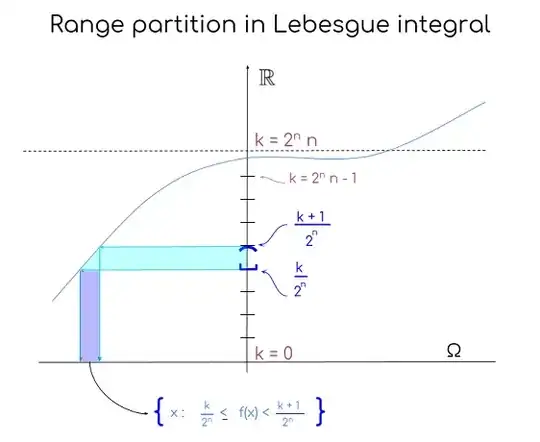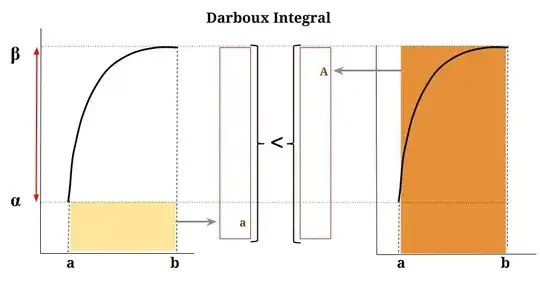This cine clip may encapsulate the concept of generating the Lebesgue integral of a continuous bounded function:

We are looking for the supremum of the sum of all possible simple functions (we can think of them as step functions), under the curve, as beautifully explained here. It makes sense to talk about supremum because we approach the value of the area under the curve with simple functions, which have a limited number of steps.
Perhaps unfortunately some of the static iconography on-line may hint at a false impression of a pyramid being built with horizontal slabs and from inside out, as in this slide from Coursera, with brick-like horizontal slabs, as opposed to simple functions:

In Lebesgue integration, there is no "lower sum" and "upper sum" converging, as in the Darboux integral. Likewise there is no overlap between any of the infinity of possible simple functions because of their "step" nature. The Lebesgue integral is defined on a measurable function $f: M\rightarrow \mathbb R$:
$$\int f\,d\mu := \text{sup} \left[\sum_{z\in s(M)} z\,\mu \left( \text{preim}\left(\{z\}\right) \right) \right]$$
where $s$ corresponds to a simple function:
Function $s$ on some measurable set (i.e. set equipped with a $\sigma$ algebra), taking it to the real line: $f: M\rightarrow \mathbb R.$
That takes only finitely many values: $s(M)=\{s_1, s_2,\cdots,s_N\}$ for some $N \in \mathbb N.$
This simple function can be written as $s = \displaystyle \sum_{z\in s(M)} \underbrace{\color{red}{\color{red}{\,z\,}}}_{\small\color{red}{\text{height}}} \, \underbrace{\color{blue}{\chi_{\text{preim}_s}(\{z\})}}_{\small\color{blue}{\text{base}}}$, with $\chi_{\text{preim}_s}(\{z\})$ being the characteristic or indicator function.
The range or codomain of the function is partitioned fixing a maximum value $n$ into $k=0$ to $k = 2^n n$ intervals at heights $\frac{k}{2^n}$ in order to defined a sequence of simple functions $f_n:$
$$f_n(x) = \sum_{k=0}^{n2^n-1}\frac{k}{2^n}\; \chi_{\frac{k}{2^n}\leq f(x)<\frac{k+1}{2^n}}\; +\; n\,\chi_{f(x) \geq n}$$
i.e. with value $n$ if $f(x)$ is equal or greater than $n,$ and otherwise with the lowest value for that interval, $\frac{k}{2^n}.$ In the indicator function above $\frac{k}{2^n}\leq f(x)<\frac{k+1}{2^n}$ can be alternatively expressed as $k \leq 2^n f(x) < k+1$ with $k=\lfloor 2^n f(x) \rfloor.$ This is explained here. Graphically,

Coding a concept helps, so I tried doing so for this post, illustrating the Lebesgue integral of $y = x^2$ between $[0,1]$. The code is here, and the output looks like this:

Finally, here is a systematic "construction" of the Lebesgue integral for an inverted parabola, really showing how the critical step is to partition the range (y axis) in $N$ equally spaced divisions between the $y$ limits of integration, defining $[y_i,y_{i+1}]$ intervals, and look for the measure of the pre-image in the $x$ axis: the difference between the inverse function at a given chosen point, $y^*$ (not a slab) for any given $[y_i, y_{i+1}]$ interval, $f^{-1}(y^*_i)$, and the inverse of the next point in the y axis, $y^*_{i+1}$. Analytically, this "strategy" relies ultimately in letting $N\rightarrow\infty$, which explains the "pyramid" iconography so often found online, which is intuitive, but has the potential to suggest the integral as a pile of horizontal slabs. This was a big hurdle understanding the difference between the Lebesgue and the Darboux integrals. Here is an attempt at a more faithful dynamic representation (again the code is here waiting for improvements):

When we extend the partitions to $100$ (a humble computer version of $\infty$) the calculated area is $1.322926$, really close to the analytical value, and identical to the Riemann integral $2\int_0^1 (-x^2 +1)\, dx=4/3.$





